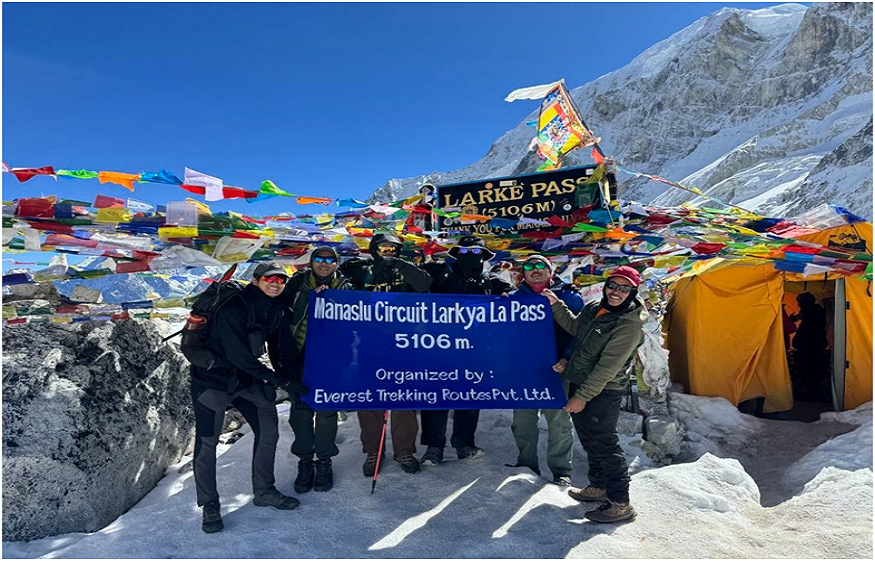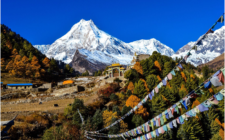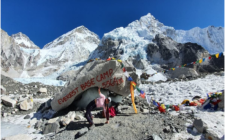Nepal is a hiker’s heaven, a country where antiquated trails wind through a few of the most elevated mountains in the world and interface immortal towns, profound valleys, and sacrosanct peaks. The encounter of trekking in this Himalayan kingdom is not at all like anyplace else on Soil. The fresh mountain discusses, the supplication banners vacillating against a scenery of snow-capped peaks, and the warm grins of the nearby individuals together make an environment of amazement, quietness, and reason. Among the numerous incredible treks that this arrival offers, four stand out as the crown gems: the Annapurna Base Camp trek, Langtang Valley trek, Manaslu Circuit trek, and Everest Three Pass Trek.
Each of these courses guarantees not as it were staggering scenes but moreover social submersion, experience, and otherworldly profundity. Together, they offer a scene of everything that makes Nepal a climbing paradise. Whether you’re a first-timer or a prepared explorer, these trails offer ventures that touch the heart and challenge the soul.
Annapurna Base Camp trek
The Annapurna Base Camp trek is one of Nepal’s most cherished trails, advertising an adjusted and wealthy trekking involvement that offers to a wide run of climbers. Arranged in central Nepal, the Annapurna region is effectively available from Pokhara and is known for its emotional territory, dynamic greenery, and multicultural villages.
The trek regularly starts at Nayapul and takes after the rich Modi Khola Stream valley, climbing through an arrangement of different scenes — terraced rice areas, bamboo timberlands, snow capped glades, and glacier-carved valleys. Each town along the path, such as Ghandruk, Chhomrong, and Deurali, grandstands conventional Gurung and Magar culture, total with stone houses, neighborhood religious communities, and inviting teahouses.
As the path rises, the way leads to the awe-inspiring Annapurna Haven, a characteristic amphitheater ringed by a few of the most celebrated peaks in the Himalayas: Annapurna I (8,091 m), Machapuchare (Fishtail), Hiunchuli, and Gangapurna. Coming to Annapurna Base Camp at 4,130 meters is both an enthusiastic and visual climax. Encompassed by towering dividers of ice and shake, the sense of lowliness and respect is palpable.
What makes the ABC trek extraordinary is its openness without relinquishing the glory of the tall Himalayas. It’s idealized for those who need the full mountain encounter inside a 7–12 day trip, with comfortable teahouse housing and social abundance at each turn.
Langtang Valley trek
For those looking for quietness and realness, the Langtang Valley trek is a covered up pearl tucked near to Kathmandu however advertising a farther and otherworldly involvement. After a beautiful drive to Syabrubesi, the path takes after the Langtang Khola waterway, weaving through thick oak and rhododendron woodlands, cascading waterfalls, and yak pastures.
The region was profoundly influenced by the 2015 seismic tremor, but its recuperation has been a confirmation to the strength of the neighborhood communities. As you climb toward the towns of Lama Lodging, Langtang Town, and Kyanjin Gompa, you’ll take note of the Tibetan Buddhist impact in supplication banners, mani dividers, and stone stupas. The nearby Tamang individuals, accepted to be of Tibetan plunge, offer wealthy social trades and honest to goodness hospitality.
The scene steadily changes into open elevated knolls encompassed by cold peaks, coming full circle at Kyanjin Gompa (3,870 meters) — a quiet town with an old cloister and a cheese manufacturing plant. From here, side climbs to Tserko Ri (4,984 m) or Kyanjin Ri offer exceptional all encompassing sees of Langtang Lirung (7,227 m), Dorje Lakpa, and ice sheets that plummet into the valley.
The Langtang trek regularly takes 7–10 days and is appropriate for trekkers of all levels. It’s a perfect trip for those who need isolation, otherworldly knowledge, and a chance to bolster a community that warmly invites guests in spite of past hardships.
Manaslu Circuit trek
The Manaslu Circuit trek is an enterprise for the more gutsy soul, an endeavor around the base of Mount Manaslu (8,163 meters) — the eighth most elevated mountain in the world. Generally untouched by cutting edge improvement and less swarmed than other major courses, the path offers an interesting blend of tough mountain view and profoundly protected Tibetan-influenced culture.
Starting from Soti Khola, the path follows the Budhi Gandaki Waterway, crossing suspension bridges, cascading waterfalls, and terraced hills. As you pick up elevation, the scene gets more sensational, with towering cliffs, profound gorges, and old stone towns clinging to hills. The towns of Namrung, Sama Gaun, and Samdo serve as social highlights, where you’ll experience centuries-old religious communities, turning supplication wheels, and nearby friars in dark red robes.
Reaching Larkya La Pass (5,106 meters) is the physical and otherworldly climax of the trip. The pass is long and strenuous, regularly snow-covered, but offers stunning views of Himlung Himal, Cheo Himal, and the Annapurna extend. The sense of isolation and achievement at this point is immense.
The full trek takes around 14–18 days and requires extraordinary licenses as it is a limited region. Trekkers must travel with an enrolled direct, which upgrades the security and social understanding of the travel. The Manaslu Circuit is perfect for those who need an untainted Himalayan involvement that jumps profoundly into mountain wild and antiquated ways of life.
Everest Three Pass trek
For prepared explorers looking for the extreme challenge, the Everest Three Pass trek is the crown gem of Himalayan trekking. Combining components of enterprise, height, and breathtaking view, this circuit offers the most comprehensive trekking involvement in the Khumbu region — domes of Mount Everest (8,848 meters).
This route begins from Lukla, taking after the classic Everest Base Camp course through Phakding, Namche Bazaar, and Tengboche. But not at all like the customary EBC trek, it branches into a circle that crosses three marvelous tall passes: Kongma La (5,535 m), Cho La (5,420 m), and Renjo La (5,360 m). Each pass presents an imposing challenge, with cold territory, snowfields, and lean, but too unparalleled views of Everest, Lhotse, Makalu, Cho Oyu, and incalculable lesser-known peaks.
Of course, trekkers visit notorious points of interest like Everest Base Camp (5,364 m), the all encompassing perspective of Kala Patthar (5,545 m), and the Gokyo Lakes, whose turquoise waters reflect the encompassing frigid monsters. The town of Thame, the origin of renowned worldwide climber Tenzing Norgay, includes authentic reverberation to the trek.
Taking 18–21 days, this is a high-stakes experience that requests great physical conditioning, appropriate acclimatization, and involvement at height. But for those who embrace it, the Everest Three Pass trek is not a fair climb — it’s a trek through the kingdom of the divine beings, filled with dramatization, motivation, and recollections that final a lifetime.
The Soul of the Mountains
Beyond the physical scenes, what makes these treks transformative is the human and otherworldly encounter. The Himalayan trails are not fair courses through mountains; they are life savers that interface individuals, history, and conviction systems.
In Annapurna, the combination of Hindu and Buddhist societies comes alive through town ceremonies and sacrosanct sanctuaries. In Langtang, the concordance of nature and supplication talks through chortens and shuddering banners. In Manaslu, the segregation extends your association with the divine quiet of farther valleys. And in Everest, the nearness of Everest herself — Sagarmatha, the Mother of the Universe — imbues each step with a respectful sense of awe.
The straightforwardness of teahouse life — sharing dinners of dal bhat, tasting hot tea close to wood stoves, exchanging stories with individual trekkers — includes warmth to the long, cold climbs. Guides and watchmen ended up trusted companions, frequently singing conventional melodies or advertising a calm grin that lifts your soul when the path feels endless.
Preparation & Common Sense Tips
To really appreciate these trails, appropriate planning is key. Here are a few basics for yearning trekkers:
Best Seasons: Spring (March–May) and Harvest time (September–November) offer the best climate and views.
Fitness: Construct continuance through customary climbs and cardiovascular workouts. For Everest or Manaslu, consider preparing at height if possible.
Gear: Layered clothing, waterproof boots, trekking posts, resting pack (appraised for cold), headlamp, and a great rucksack are crucial.
Permits:
- Annapurna and Langtang require a TIMS card and preservation zone permits.
- Manaslu requires a Confined Region Allow, also MCAP and ACAP.
- Everest requires a Khumbu Provincial Region permit and Sagarmatha National Stop permit.
- Acclimatization: Take rest days, hydrate well, and tune in to your body. Height ailment is genuine and can be dangerous.
Guides and Porter: Contracting a nearby direct enhances your travel through social experiences and guarantees security, whereas watchmen offer assistance carrying loads and back nearby livelihoods.
Preparation & Practical Tips
To truly enjoy these trails, proper preparation is key. Here are a few essentials for aspiring trekkers:
- Best Seasons: Spring (March–May) and Autumn (September–November) offer the best weather and views.
- Fitness: Build endurance through regular hikes and cardiovascular workouts. For Everest or Manaslu, consider training at altitude if possible.
- Gear: Layered clothing, waterproof boots, trekking poles, sleeping bag (rated for cold), headlamp, and a good backpack are crucial.
- Permits:
- Annapurna and Langtang require a TIMS card and conservation area permits.
- Manaslu requires a Restricted Area Permit, plus MCAP and ACAP.
- Everest requires a Khumbu Rural Municipality permit and Sagarmatha National Park permit.
- Acclimatization: Take rest days, hydrate well, and listen to your body. Altitude sickness is real and can be dangerous.
- Guides and Porters: Hiring a local guide enriches your trek through cultural insights and ensures safety, while porters help carry loads and support local livelihoods.
Why Trek Nepal?
Trekking in Nepal is about more than just the mountains. It’s about connecting with a land where nature and culture are inseparable, where every trail tells a story, and every step brings you closer to something greater. Whether you find peace by a silent glacier or strength atop a windy pass, you’ll return from Nepal changed in ways you didn’t expect.
The Annapurna Base Camp, Langtang Valley, Manaslu Circuit, and Everest Three Pass Trek represent the very essence of Nepal’s trekking spirit. They invite you not only to witness the Himalayas, but to become part of their timeless rhythm — a rhythm of footfalls, prayer wheels, and whispered wind between the peaks.
Contact Details
Company address: Everest Trekking Routes Pvt. Ltd.
16 Khumbu, Nayabazaar, Kathmandu, Nepal
Mobile : +977-9843467921 (Rabin)
Email: [email protected]




